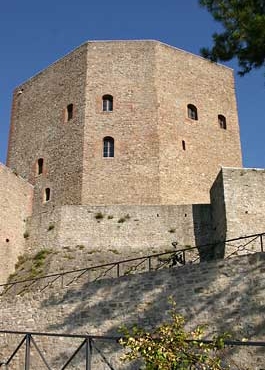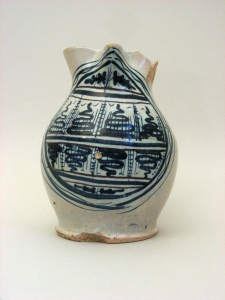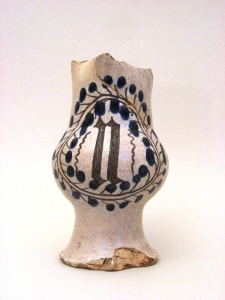 The
exhibition “The Colors of Montefiore’s Fortress”, organized in the recently
restored rooms of the fortress, marks the beginning of the new role of the
Malatestiana fortress which will became in the near future the territory’s
Museum.
The
exhibition “The Colors of Montefiore’s Fortress”, organized in the recently
restored rooms of the fortress, marks the beginning of the new role of the
Malatestiana fortress which will became in the near future the territory’s
Museum.
This first exhibition consolidates existing studies on the production of
ceramics’ during the Malatestiana period; however, the exhibition also adds
two new elements. The first is the possibility to transform it from a
temporary to a permanent exhibition; the second one is the location, the
Fortress’s rooms which underwent restoration recently and have been open to
the public for the past few months. Archeological items were excavated in
these rooms during the restoration, and these items are also on exhibit. The
analysis of these items (over 500 ceramics, metals and glass have so far
been inventoried) has enabled a unique reconstruction of the Montefiore
historical period, something that has not been hitherto possible considering
that existing historical scripts only provide a general understanding of
this period. This is because many of the recovered ceramics are samples of
everyday life objects, dating from the early 14th to the end of 15th
century, and thanks to this it is now possible to know more about the life
of this period such as its crafts, cultural exchanges, food habits,
political systems, women and warriors.


The Archeological Excavation
Based on historical scripts, historians have estimated that the castle was
constructed between 1337 and 1347. The recently excavated items have
generally confirmed these dates. The castle, still standing today, is the
result of it having undergone several transformations during the second and
third period of its life. The castle reflects the various architectural
periods, the eldest of which is from the 14th Century and the most recent
that of the 15th.
The south-west section of the castle, composed by room C and D and its
stairwell connections, is the eldest, while the rest of the rooms on the
ground floor have been constructed subsequently and were used mainly for
services. All the apartments, boardrooms included, were located on the upper
floors.
The eldest Malatestian period has its evidence in a series of structures and
service rooms excavated in the basement rock whose evident breaking and
holes were most probably due to the use of scaffolding to build up the
fortress itself.
The main structure discovered in Room A is documented by the huge tank-well
used for water collection and it is located right in the middle of the room.
Partially excavated in the rock, it has quadrangular shape and walls coated
with waterproofing clay. The well is located in the middle and is covered
with loose bricks. The gap between the walls and the well is filled with
sand, whose function is to filter the water out. The water reached the tank
through a series of pipes located into the brickwork, collecting the rain
directly from the roof straight to the tank , to be then filtered by the
sand and collected into the well. The most interesting aspect of all this,
is given by a series of existing pits made of brick (one located in Room A
and three in Room B) and placed right into the basement rock. These were
built one after the other and remained in use up till the very last phase of
the castle (early 17th century). Their structure is composed by a simple
brick vault with rectangular plan, plus two or three draining with
trapdoors. Such draining were used progressively. Once filled up, the
trapdoor was closed and welded, on order to avoid the spread of unpleasant
fluids. At the high level, corresponding to the main room of the pits, it
appeared just a wall with leading squared rooms equipped with doors with
thresholds, in which there was a trapdoor used to through the garbage away.
The excavation of such scrap-yards has made possible to recover a huge
quantity of majolica, some of it already restored, others being restored. In
practice, all the different phases of majolica productions can be found
here: even the most archaic such as the jugs (????) some of which have the
Malatestian armorial bearings with shield and transversal bands, or the
“zaffera a rilievo”.
Or cups and plates in “floral gothic” or “alla porcellana” style with
decorations and symbols such as the big plate for exhibition of The
Montefeltro with the horned eagle; less numerous were the graffiti from the
Renaissance made in Ferrara, or the decorated majolica from the Renaissance
(16th century ), up till the early 17th century compendiari from Faenza.
Big dish (end XV- beginning XVI century) with crowded eagle decoration,
symbol of Montefeltro's Family


